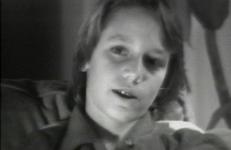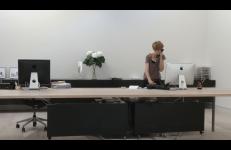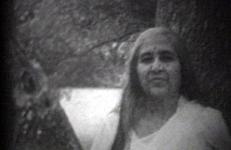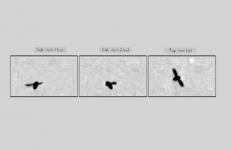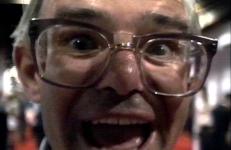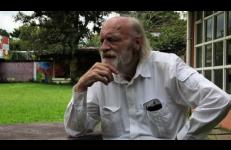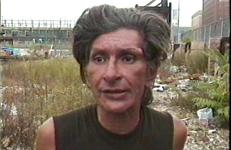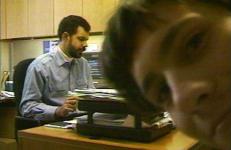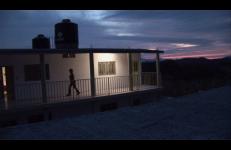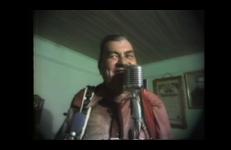Shot during the fall of 2009 in Wesleyan University, this short documentary follows Eiko & Koma as they construct the first exhibition of their Retrospective and ponder upon questions the project asks. Directed and edited by Joanna Arnow.
Documentary
Representing the complex lives of transgender and gender variant musicians in the US and Canada, Riot Acts offers a first-hand perspective of the intersections between gender performance and stage performance. The featured performers are talented, inspiring, sexy, critical and three-dimensional in a manner that purposefully counters mainstream media. Discussions range from songwriting, performance, voice presentation and voice changes, passing/not passing, audience, to the idea of the spectacle, drag, and media representation - the personal is always political.
The Ruling Classroom documents a social studies experiment played out by seventh graders in Mill Valley, California. The students reorganized their classroom as an imaginary country until the principal staged a coup and brought the classroom republic to a halt. The educational experiment was the brainchild of teacher George Muldoon, who suspended the normal social studies curriculum in order to let his students learn about government by constructing it for themselves.
The Ruling Classroom documents a social studies experiment played out by seventh graders in Mill Valley, California. The students reorganized their classroom as an imaginary country until the principal staged a coup and brought the classroom republic to a halt. The educational experiment was the brainchild of teacher George Muldoon, who suspended the normal social studies curriculum in order to let his students learn about government by constructing it for themselves.
"Three months in an architects’ firm in Berlin. From the architecture down to the tiniest door handle, a questioning of matter and the verb."
— Harun Farocki
In 1991 Montano met a Hindu couple at Ananda Ashram, the meditation center she attends in upstate New York. Since then, the three have become friends. Mr. and Mrs. Mehta are Ayruvedic doctors; both physically resemble another Indian couple—saints Sharada and Ramakrishna, who lived in Calcutta in the 1800s—and are both known for their incredible devotion to the mystical life. Montano made this postmodern documentary to honor the Mehtas, to present an idealized model for a spiritual relationship and to hold out the possibility for spiritual ecstasy in everyday life.
A pro-domme gives her friend a freshly shaved head. In return she gets a buzz cut. A client gets to be a (bound) fly on the wall.
This title is also available on Chicago Sex Change: 2002-2008, A collection of Minax's early videos that together create a punk-documentary tapestry of young queer life in Chicago in the early 2000s.
My teaching assistant during the spring semester (Marc Rokoff) at the San Francisco Art Institute began shooting a documentary of me and the students making our sci-fi drama, The Planet of the Vamps. Three years later it remained unfinished as he felt inadequate as a documentarian, and so I was offered the box of tapes to edit. I took on the task and the result is a lively record of the production class in action as it tackles the teleplay with a minuscule budget and scanty costuming.
Executive Producer, Suzanne Lacy; Director, Steve Hirsch; Editor, Doug Gayeton.
From the performance Freeze Frame: Room for Living Room by Suzanne Lacy, Julia London, Ngoh Spencer, and Carol Leigh, San Francisco, 1982.
The Soft Science “Cinema of Attractions” is a series of short movies by scientists. Commission and concept by Rachel Mayeri, electronic compositions and musical accompaniment by Joe Milutis. Many of the videos can be found on the web, posted for public appreciation of a scientist's lab work, as instructional material, or for communication to peers as data. As "data," the videos are non-narrative, scientific information.
The Soft Science “Cinema of Attractions” is a series of short movies by scientists. Commission and concept by Rachel Mayeri, electronic compositions and musical accompaniment by Joe Milutis. Many of the videos can be found on the web, posted for public appreciation of a scientist's lab work, as instructional material, or for communication to peers as data. As "data," the videos are non-narrative, scientific information.
In this irreverent and hilarious videotape, renowned street performer Stoney Burke leads us on a subversive tour of the 1992 Republican National Convention in Houston’s Astrodome. Burke disregards the traditional terms of “political debate” offered by the network news establishment, and zeroes in on the questions that never get asked, confronting such Republican luminaries as Oliver North, Neil Bush, Pat Robertson, Jack Kemp, Sen. Alfonse D’Amato, and Rush Limbaugh (among others), on issues that are glossed over during the convention.
Strike Anywhere is a video essay that takes as its point of departure Swedish "Match King" Ivar Kreuger, whose privatization of financial crisis management strategies bears a direct relation to late-20th Century policies implemented by the IMF and WTO. Between 1917 and 1932, Kreuger capitalized on shifts in global financial markets to control over 200 companies and establish matchstick monopolies in at least 34 countries. At the height of his success, Ivar Kreuger was worth approximately 30 million Swedish kronor (the equivalent of 100 billion USD today).
Strike Anywhere is a video essay that takes as its point of departure Swedish "Match King" Ivar Kreuger, whose privatization of financial crisis management strategies bears a direct relation to late-20th Century policies implemented by the IMF and WTO. Between 1917 and 1932, Kreuger capitalized on shifts in global financial markets to control over 200 companies and establish matchstick monopolies in at least 34 countries. At the height of his success, Ivar Kreuger was worth approximately 30 million Swedish kronor (the equivalent of 100 billion USD today).
A wistful film on the love of homeland.
Video artist Nurit Sharett recounts her childhood memories and converses with her Palestine-born parents who grew up in the British Mandate years. They both took part in realizing the Zionist dream of establishing the State of Israel, a dream now shattered before their eyes.
The violent overreaction to 9/11 and to the revolutions of the 1960s cannot be explained only with fear and politics. Franz Hinkelammert, a German-born liberation theologian, economist and philosopher, brings religion front and center to the discussion in a unique way. The emptiness and senselessness felt by those at the margins of a free-market utopian ideology has been filled by an extreme millenarian Christianity and other religious fundamentalisms that justify murder and torture as preemptive self-defense.
Sylvia is a portrait of the civil rights pioneer Sylvia Rivera for her memorial service in 2002, as told by her chosen family immediately following her death. "A veteran of the 1969 Stonewall uprising, Sylvia was a tireless advocate for all those who have been marginalized as the 'gay rights' movement has mainstreamed. Sylvia fought hard against the exclusion of transgender people from the Sexual Orientation Non-Discrimination Act in New York, and was a loud and persistant voice for the rights of people of color and low-income queers and trans people." --SRLP.org
“Christopher Wilcha’s fascinating feature-length video reminds us how seldom we’re allowed to see certain businesses operating from the inside. Wilcha, a 22-year-old college graduate and alternative-rock enthusiast, was hired by the Columbia Record and Tape Club—apparently as a fluke—to help launch a whole new niche-marketing division, which brought him face-to-face with the contradictory meanings of the term ‘alternative’ once it’s been embraced by the mass market.
Tell Me About Your Mother investigates matrilineal lineage, domesticity and creativity. Intimate and conversational, seven female artist friends and colleagues of mine—mostly boomers—recount their mother’s creative influence upon them. Additionally, each woman discusses the unique way(s) she distinguished herself from her mother.
Divino explains how he got introduced to video. “Filming is my profession; that’s what I was born to do... not for the work with the axe. I wasn’t born to plant. I already said this to my wife.” Today, Divino dominates the language of video and its filming and editing techniques. He also talks about working in partnership with his community.
Directed by Divino Tserewahu; edited by Tutu Nunes.
In Portuguese with English subtitles.
That Which Is Possible is a portrait of a community of painters, sculptors, musicians and writers making work at the Living Museum, an art-space on the grounds of a large state-run psychiatric facility in Queens, New York. Shot over the course of two years and structured across the arc of a day, the film observes with an intimate lens and unspools like a musical, both bracing and tender. That Which Is Possible explores the liberatory and reparative functions that creative action has for a group of artists drawn together by shared struggle.
Cande and Pancha’s daughter Maria Luisa and Marisela and Cachuchas’ daughter Veronica believe their fathers are locked in a competition for grandchildren. It’s now 3-0 Cande. Several years later, Cachuchas gives me a lesson in car repair then with Cande considers the change in score, 4-2 Cande.
Ramon's attraction to his Mexican hometown has resulted in his building a massive new residence for his family. However, his wife, Rufina and their grown children have no interest in leaving the U.S. The building has now been transformed into a hotel. The completed construction, in the middle of cornfields, while finished for 5 years, is been frustrated by the local government’s refusal to turn on the electricity.
Hermine Freed collaborates with James Ingo Freed to create a video essay/documentary that reflects upon memories of the holocaust during the design of a US memorial building. Hermine Freed provides video accompaniment that brings to life a lecture entitled The Architecture of the United States Holocaust Museum conducted by James Ingo Freed for the Architectural League at Rockefeller University, New York on November 11th 1993.
Most of TVTV’s work takes place in the city, at the center of some pop culture event. “The Good Times Are Killing Me” takes place in the country – Southwest Louisiana, around the towns of Mamou and Eunice, the heart of Cajun country. This is an indigenous culture of food, music, language, and bawdy French-language jokes – something you don’t see much anymore in America. The event is rural Mardi Gras, where beer-drinking, boudin-eating men and boys on horseback capture and behead chickens for a big gumbo and town dance.






